Observation and Analysis of Ejector Hysteresis Phenomena in the Hydrogen Recirculation Subsystem of PEMFCs
Abstract
:1. Introduction
2. Matching Selection and Experimental Test
3. Result Analysis of a Proportional Valve for the Ejector
- (1)
- Electromagnetic hysteresis: The electromagnetic force is affected by the hysteresis of the magnetization properties of magnetic materials. Specifically, when the control current changes in reciprocating fashion, there are some differences in the electromagnetic suction corresponding to the same current.
- (2)
- Friction hysteresis: Mainly due to the influence of eccentricity and friction coefficient of armature and guide sleeve, the existence of light eccentric force will also produce radial clamping force, which increases the friction hysteresis.
- (3)
- Time lag or delay effect: the main dynamic suction changes lag current changes; the situation is generally a rare or weak influence.
4. Simulation and Analysis of Influence on PEMFC Calibration
4.1. Introduction of Simulation Model
4.2. Anode Subsystem Model
4.3. Cathode Subsystem Model
4.4. Main Theoretical Calculation and Results
5. Conclusions
- (1)
- The ejector with a proportional valve can supply hydrogen and recycle hydrogen, which can replace the traditional active hydrogen circulating pump.
- (2)
- The difference in flow rate of the ejector from a proportional valve in a calibration test was verified in the experiment. The hysteresis caused by different flow rates leads to the deviation of the primary flow of the ejector. Additionally, the main reason for hysteresis is the force of proportional valve armature in the loading and unloading processes.
- (3)
- The simulation results show that the hysteresis causes the deviation of PEMFCs’ dynamic performance. If there is no control compensation measure, the stack output power is higher in unloading process than in loading process. Therefore, it is necessary to reduce the dynamic deviation of ejector primary flow by controlling compensation.
- (4)
- The PV control current can be calculated by a double lookup curve in PEMFC system calibration, which can effectively reduce the primary flow deviation of ejector. The content of this paper can provide reference for the subsequent development and research of PEMFCs.
Author Contributions
Funding
Institutional Review Board Statement
Data Availability Statement
Conflicts of Interest
References
- Peters, G.P.; Friedlingstein, P.; Jackson, R.B.; Le Quéré, C.; Peregon, A. Carbon dioxide emissions continue to grow amidst slowly emerging climate policies. Nat. Clim. Change 2020, 10, 3–6. [Google Scholar] [CrossRef]
- Besagni, G.; Mereu, R.; Inzoli, F.; Chiesa, P. Application of an integrated lumped parameter-CFD approach to evaluate the ejector-driven anode recirculation in a PEM fuel cell system. Appl. Therm. Eng. 2017, 121, 628–651. [Google Scholar] [CrossRef]
- Wang, J. Theory and practice of flow field designs for fuel cell scaling-up: A critical review. Appl. Energy 2015, 157, 640–663. [Google Scholar] [CrossRef]
- Yang, L.; Yinghong, W.; Bo, L.; Tiande, M.; Yu, L.; Shien-Ping, F.; Jingkui, Q.; Paul, K.C. Development and application of fuel cells in the automobile industry. J. Energy Storage 2021, 42, 103124. [Google Scholar]
- Xie, F.; Shao, Z.; Hou, M.; Yu, H.; Song, W.; Sun, S.; Zhou, L.; Yi, B. Recent progresses in H 2 -PEMFC at DICP. J. Energy Chem. 2019, 36, 129–140. [Google Scholar] [CrossRef] [Green Version]
- Li, D.; Yu, Y.; Jin, Q.; Gao, Z. Maximum power efficiency operation and generalized predictive control of PEM (proton exchange membrane) fuel cell. Energy 2014, 68, 210e7. [Google Scholar] [CrossRef]
- Yong, Z.; Shirong, H.; Xiaohui, J.; Yuntao, Y.; Mu, X.; Xi, Y. Characteristics of proton exchange membrane fuel cell considering “dotmatrix” gas distribution zones and waveform staggered flow field with cooling channels. Energy Convers. Manag. 2022, 267, 115881. [Google Scholar] [CrossRef]
- Zhang, G.B.; Jiao, K. Multi-phase models for water and thermal management of proton exchange membrane fuel cell: A review. J. Power Sources 2018, 391, 120–133. [Google Scholar] [CrossRef]
- Adzakpa, K.P.; Ramousse, J.; Dubé, Y.; Akremi, H.; Agbossou, K.; Dostie, M.; Poulin, A.; Fournier, M. Transient air cooling thermal modeling of a PEM fuel cell. J. Power Sources 2008, 179, 164–176. [Google Scholar] [CrossRef]
- Kim, D.K.; Seo, J.H.; Kim, S.; Lee, M.K.; Nam, K.Y.; Song, H.H.; Kim, M.S. Efficiency improvement of a PEMFC system by applying a turbocharger. Int. J. Hydrogen Energy 2014, 39, 20139–20150. [Google Scholar] [CrossRef]
- Kim, M.; Sohn, Y.; Cho, C.; Lee, W.; Kim, C. Customized design for the ejector to recirculate a humidified hydrogen fuel in a submarine PEMFC. J. Power Sources 2008, 176, 529–533. [Google Scholar] [CrossRef]
- Stefanski, F.; Minorowicz, B.; Persson, J.; Plummer, A.; Bowen, C. Non-linear control of a hydraulic using a generalised Prandtl–Ishlinskii hysteresis model. Mech. Syst. Signal Process. 2017, 82, 412–431. [Google Scholar] [CrossRef] [Green Version]
- Huang, J.; Wang, X.; Wang, H.; Hao, H. Development of a flow control valve with digital flow compensator. Flow Meas. Instrum. 2019, 66, 157–169. [Google Scholar] [CrossRef]
- Moçotéguy, P.; Druart, F.; Bultel, Y.; Besse, S.; Rakotondrainibe, A. Monodimensional modeling and experimental study of the dynamic behavior of proton exchange membrane fuel cell stack operating in dead-end mode. J. Power Sources 2007, 167, 349–357. [Google Scholar] [CrossRef]
- Hwang, J.-J. Effect of hydrogen delivery schemes on fuel cell efficiency. Power Sources 2013, 239, 54–63. [Google Scholar] [CrossRef]
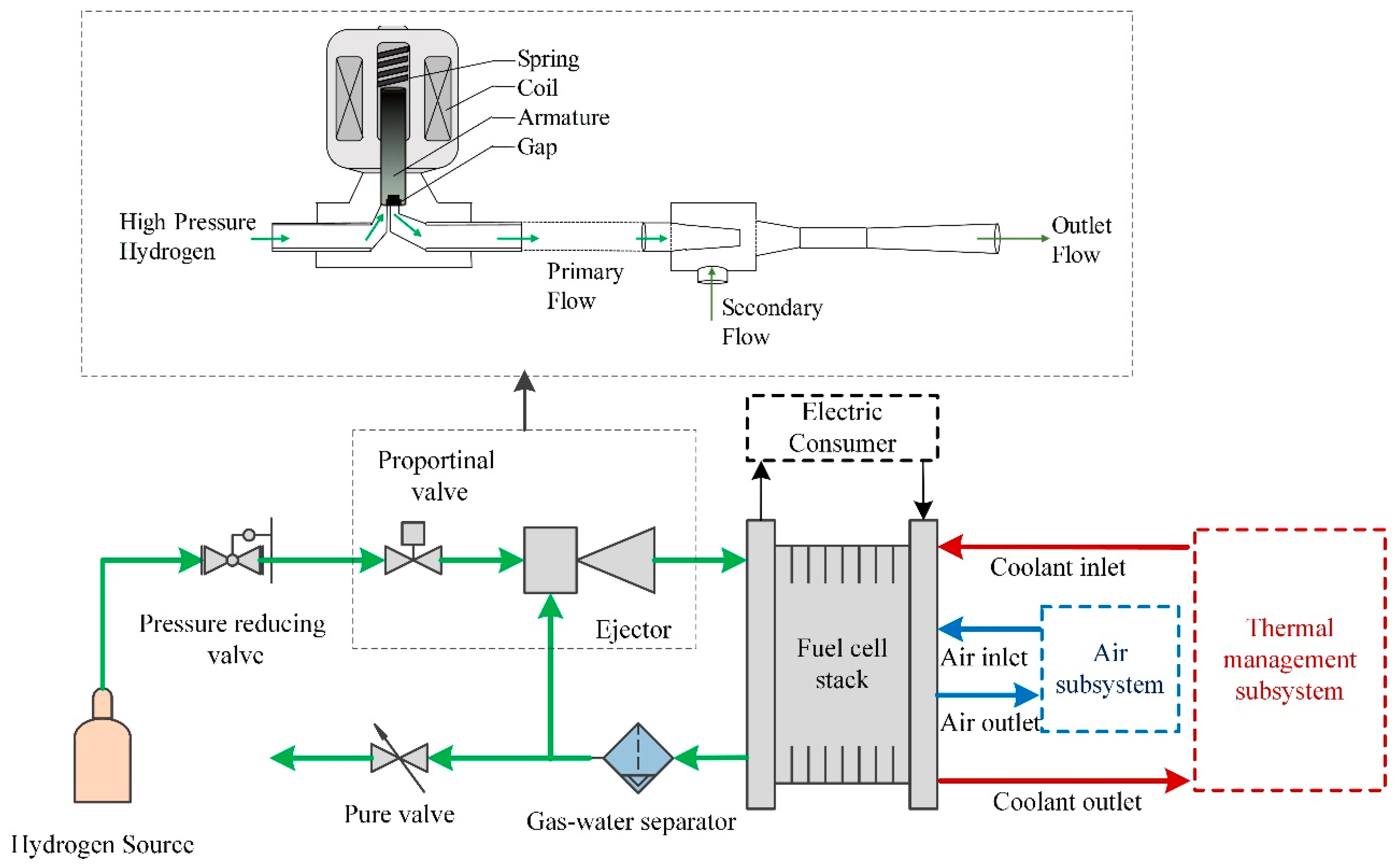
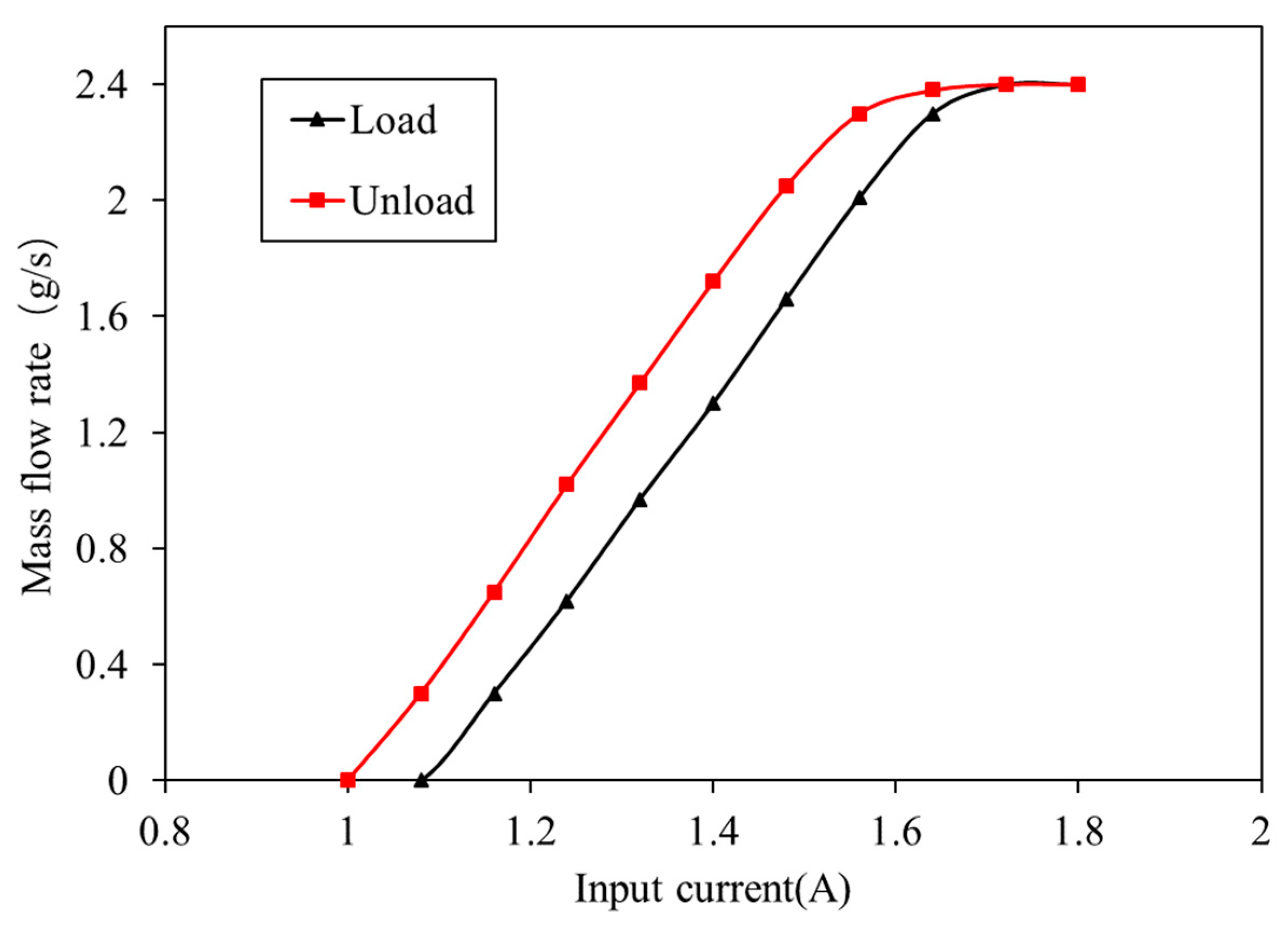

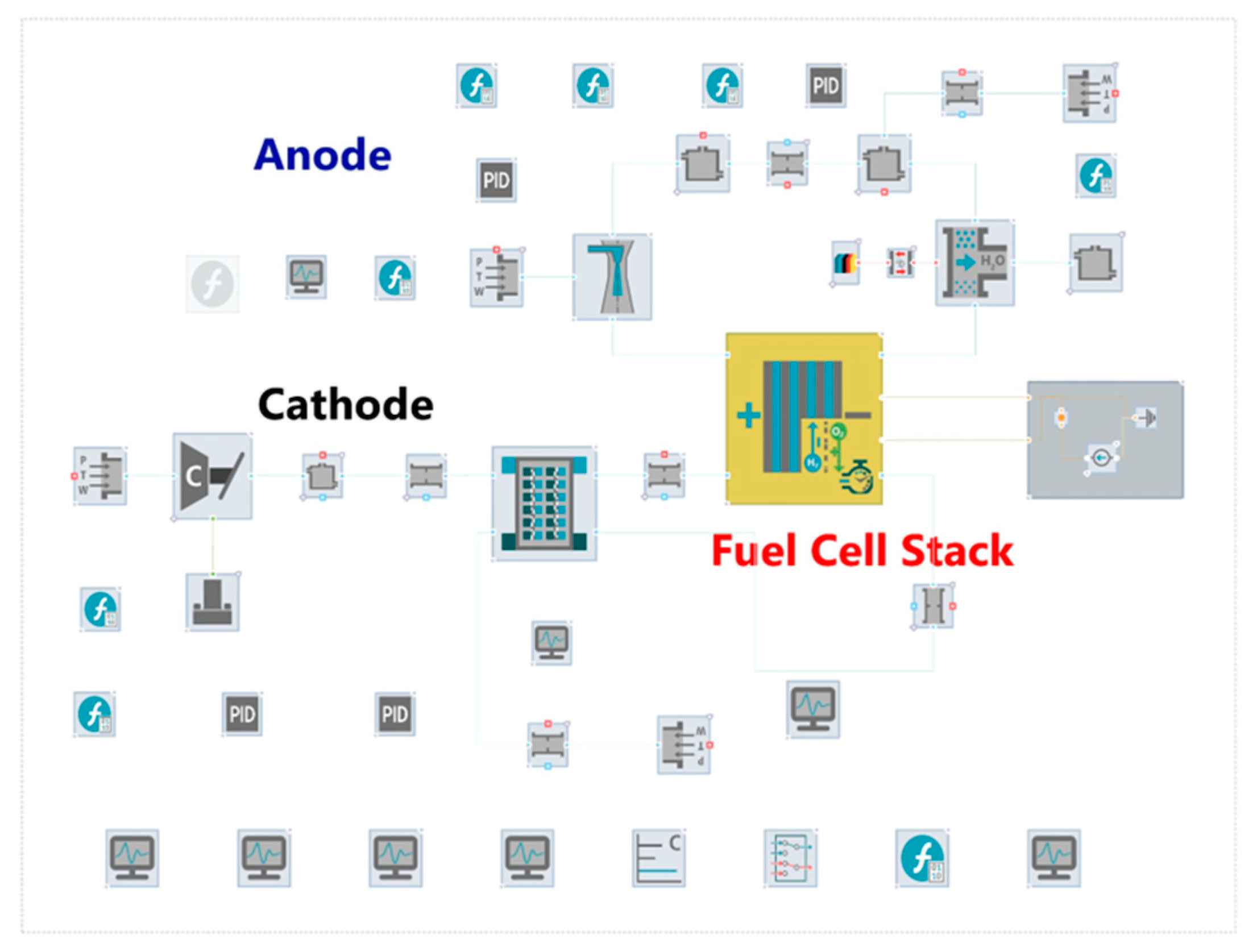


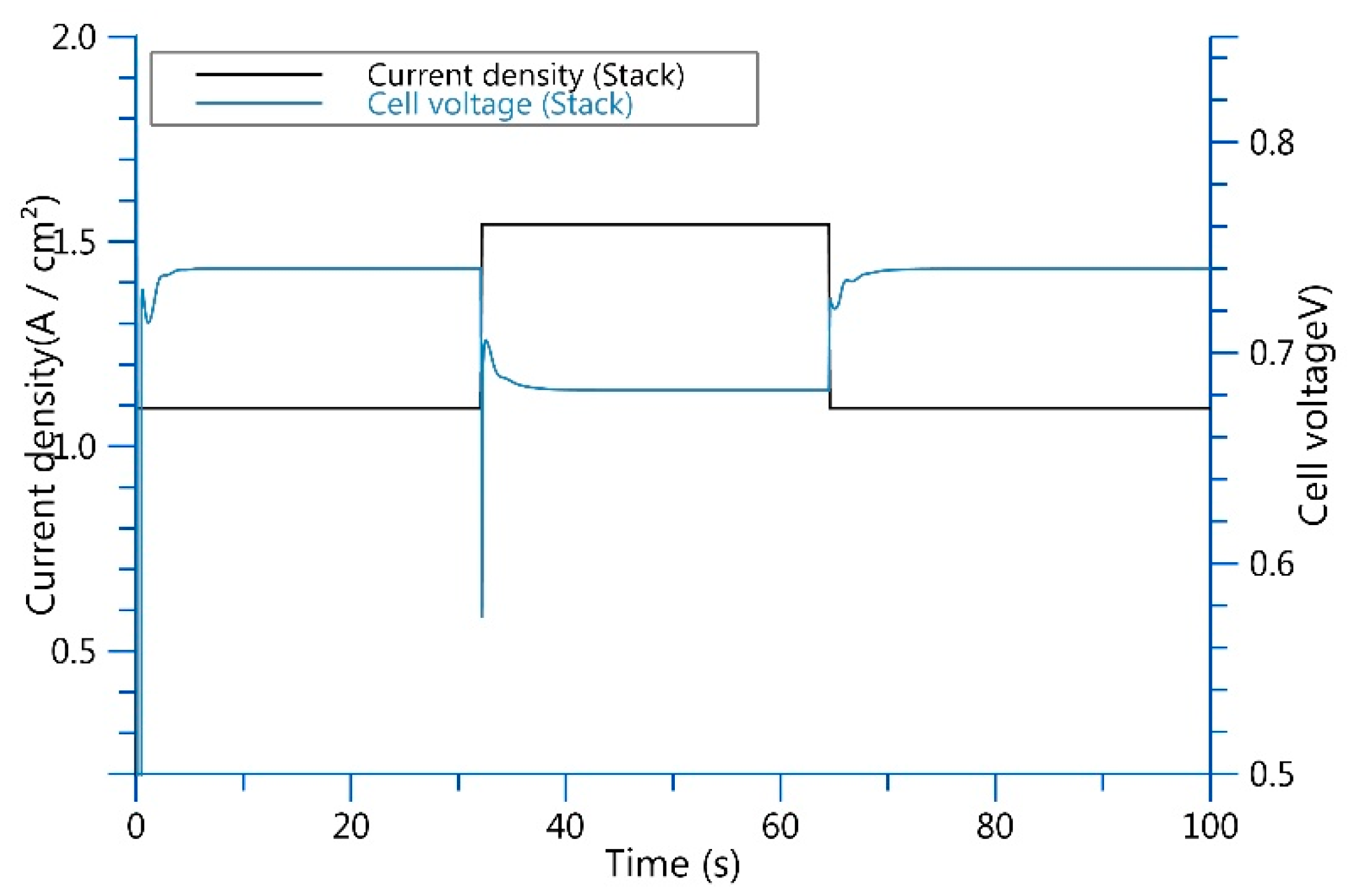
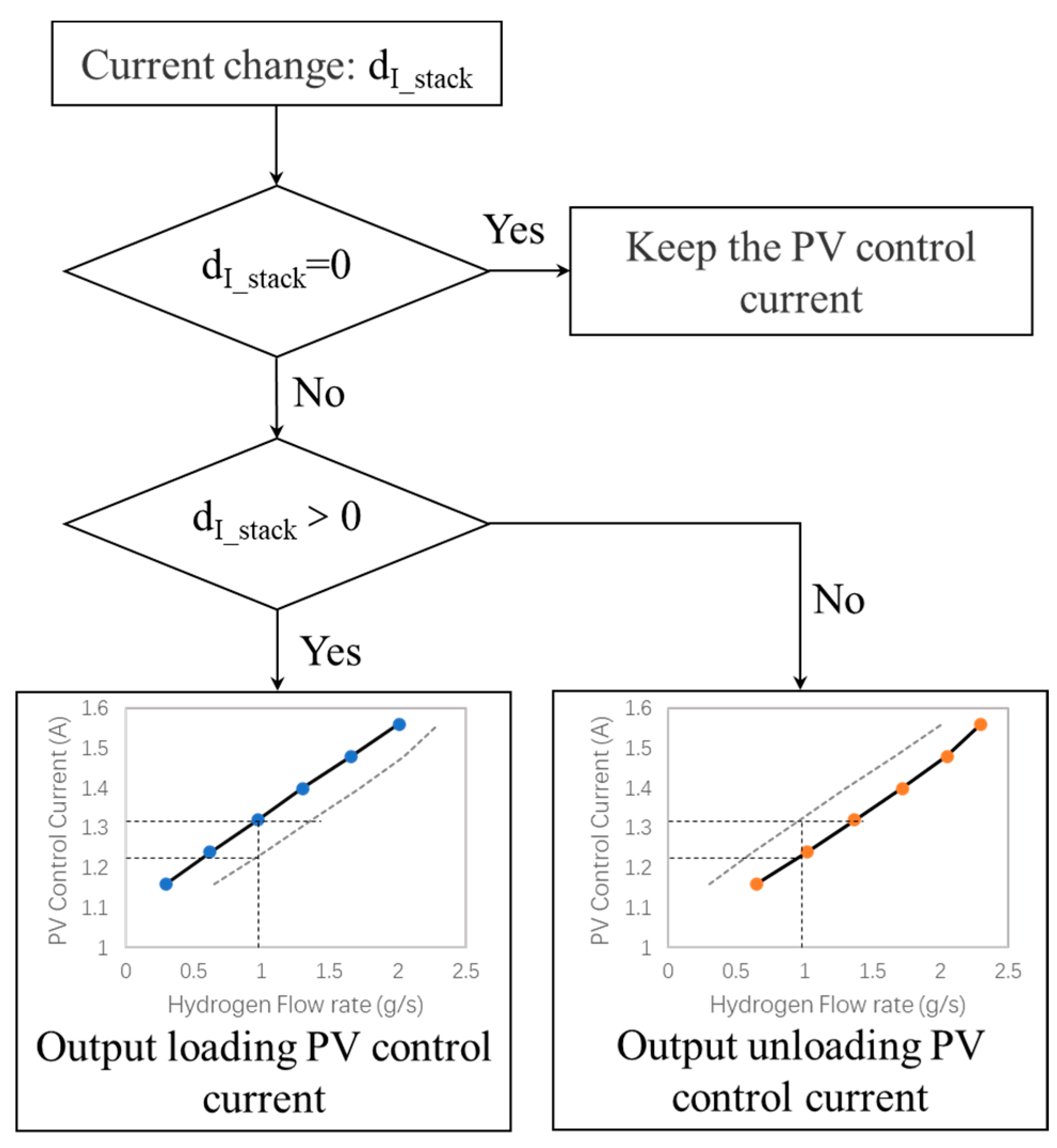

| Input Current (A) | Mass Flow Rate of Fuel Cell Load (g/s) | Mass Flow Rate of Fuel Cell Unload (g/s) |
|---|---|---|
| 1 | 0.01 | 0.00 |
| 1.08 | 0.01 | 0.30 |
| 1.16 | 0.30 | 0.65 |
| 1.24 | 0.62 | 1.02 |
| 1.32 | 0.97 | 1.37 |
| 1.4 | 1.30 | 1.72 |
| 1.48 | 1.66 | 2.05 |
| 1.56 | 2.01 | 2.30 |
| 1.64 | 2.30 | 2.38 |
| 1.72 | 2.40 | 2.40 |
| 1.8 | 2.40 | 2.40 |
Disclaimer/Publisher’s Note: The statements, opinions and data contained in all publications are solely those of the individual author(s) and contributor(s) and not of MDPI and/or the editor(s). MDPI and/or the editor(s) disclaim responsibility for any injury to people or property resulting from any ideas, methods, instructions or products referred to in the content. |
© 2023 by the authors. Licensee MDPI, Basel, Switzerland. This article is an open access article distributed under the terms and conditions of the Creative Commons Attribution (CC BY) license (https://creativecommons.org/licenses/by/4.0/).
Share and Cite
Li, M.; Lin, M.; Wang, L.; Wang, Y.; Pan, F.; Zhao, X. Observation and Analysis of Ejector Hysteresis Phenomena in the Hydrogen Recirculation Subsystem of PEMFCs. Entropy 2023, 25, 426. https://doi.org/10.3390/e25030426
Li M, Lin M, Wang L, Wang Y, Pan F, Zhao X. Observation and Analysis of Ejector Hysteresis Phenomena in the Hydrogen Recirculation Subsystem of PEMFCs. Entropy. 2023; 25(3):426. https://doi.org/10.3390/e25030426
Chicago/Turabian StyleLi, Mingyang, Mingxing Lin, Lei Wang, Yanbo Wang, Fengwen Pan, and Xiaojun Zhao. 2023. "Observation and Analysis of Ejector Hysteresis Phenomena in the Hydrogen Recirculation Subsystem of PEMFCs" Entropy 25, no. 3: 426. https://doi.org/10.3390/e25030426






